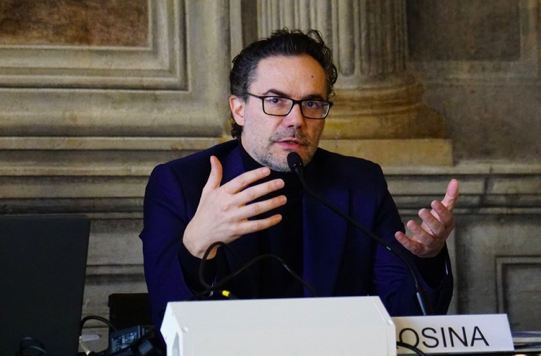«Let’s imagine the future as a house, made of bricks. These bricks are the people. These people are the new generations, who shape what we all will be».
This reflection opens a summary of what Dr. Alessandro Rosina, Professor of Demography and Social Statistics at the Catholic University of Milan and Scientific Coordinator of the Youth Observatory of the G. Toniolo Institute, explained during the conference organised by our Project Direction Employment in Bologna (picture: Mathias Marchioni – coop. Lai-momo)
Considering the initial metaphor, the problem is that we have fewer young people, and therefore… less bricks.
In addition, in Italy, we donate these bricks to other Countries, as said by Dr. Rosina highlighting the theme of the expatriation of young people who go to enlist in the workforce of other countries. Finally, sometimes we ‘waste’ these bricks: what we are wasting are the NEETs.
When we think of demographic issues/transformations, we think above all of the increase in the elderly population, meaning the population aging. However, what characterises our time the most, is having fewer and fewer young people, in such a new way that we lack a specific term to indicate this process. ‘Quantitative dejuvenation’is the name given to this phenomenon because it is a process that could not remain without a name. One can think about the Second World War: just after it we grew up with the majority of the population being under 30-year-old. Today, this is no longer the case. In Italy, the actual percentage of under 30 is around 27%: the lowest among developed European countries.
And… there is another factor to consider. There is also a problem from a qualitative point of view, since there are fewer spacesand opportunities for entering the world of work.
The NEET indicator is as well capable of indicating how much the territory wastes that portion of the population during changing processes (as the time we are living). If a young person is not put in a position to study and train, the problem is right there: one is not an active subject capable of dealing with the reality. This also becomes a message of disinterest from a society, which is not capable of providing the right tools and giving the possibility of experimenting to the new generations who, on the other hand, would be a fundamental resource for the society itself, since they represent its future.
In addition, with the impact of the pandemic, the NEET percentage in Italy is at 23% compared to 13% in the European Union, so the gap has remained high, not even returning to pre-pandemic levels. And, unfortunately, this is perceived by young people themselves: more than 45% of young people in Italy think that things have been done worse than in other Countries.
What we need are policies able to deal with those issues. There are as well many fragilities scattered along the path from school to work, and in this case as well the perception of young people is very clear. In fact, factors concerning difficulties such as lack of active policies, employment services, etc., are systematically higher.
Another metaphor, then? We could talk about young people in a labyrinth. Many young people who leave the school and enter the work gates find it difficult to orient themselves in this ‘labyrinth’. NEETs are precisely those young people who get lost in it. At first, they are unemployed in a technical sense, then they become discouraged because they don’t find a job, until they no longer believe in it, then they fall off the public policy radars and no one is looking for them anymore. The risk is becoming a social cost rather than an active part.
This is why a broad social partnership becomes important, to be capable of intercepting these young people in conditions of hardship, a situation which often already start from within the school, with the risk of demotivation and little stimulus (also because in some parts of Italy there is also little orientation towards work).
It is important, then, to make young people protagonists of job development processes by overturning the perspective: they are not only NEETs but important resources from which to draw out potential and opportunities. Therefore, adequate training is important, and at the center of this strengthening there must be skills, those that can be used today to enter the world of work and the ‘advanced ones’, i.e. those that anticipate what will be needed tomorrow, in addition to life-skills and active citizenship (i.e. social and not just technical ones). We need them to avoid being or becoming NEETs, since this means, after all, ‘not doing well’: I train but not well àI lack skills àI have frustrations àI lose trust àRisk of drifting!
And social skills of active citizenship are actually very important, because the technical ones can be recovered, but if trust and sociability are lacking, the recovery process is much more difficult. So, trapping in the NEET category means losing life-skills. This is what must be avoided and what we must work on, despite the fact that everything has become complicated with the pandemic which has left heavy marks, because all life-skills have been reduced.
Today, to conclude, we see a sort of overlap between the historical moment we are living in and the moment of those who are about to start an active and professional life. There is less certainty about the future but at the same time the new generations are more open to change and innovation.
Our job, therefore, is to move more and more towards the perspective of change and innovation! Starting a new path with their – young people – energy.
Thanking Dr. Alessandro Rosina for this analysis, one can find more info and materials directly on his official website: www.alessandrorosina.it
Reporting his comments, statistic and explanations,
we hope that they will be useful for further reflections.


